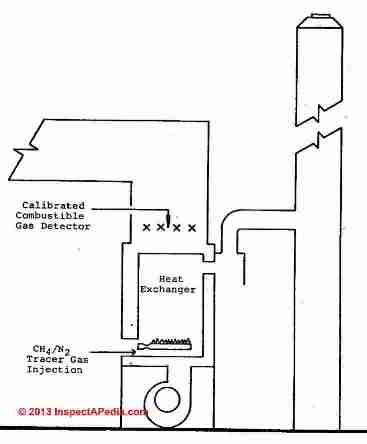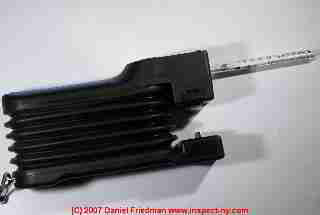 Furnace Heat Exchanger Test
Furnace Heat Exchanger Test
3-Step Method for Detecting Unacceptable Flue
Gas & CO Leakage
- POST a QUESTION or COMMENT about methods for detecting furnace heat exchanger damage, cracks, holes, leaks, carbon monoxide spillage
Furnace heat exchanger leak testing procedures:
How to determine if a furnace heat exchanger is unsafe due to leakage.
This article describes a proposed three-step method for testing residential furnace heat exchangers for leaks.
InspectAPedia tolerates no conflicts of interest. We have no relationship with advertisers, products, or services discussed at this website.
- Daniel Friedman, Publisher/Editor/Author - See WHO ARE WE?
Three Step Method for Detecting Unacceptable Flue Gas Leakage from Furnace Heat Exchangers
 Douglas W. DeWerth, P.E. - The ASHI Technical Journal, Vol. 2 No. 1, July1991, (D. Friedman, Ed.), Reprinted with permission, This paper was originally printed by
the Gas Research Institute, GRI 84/0162.
Douglas W. DeWerth, P.E. - The ASHI Technical Journal, Vol. 2 No. 1, July1991, (D. Friedman, Ed.), Reprinted with permission, This paper was originally printed by
the Gas Research Institute, GRI 84/0162.
Heat Exchanger Leak Detection: Introduction
Watch out: The following articles on methods for detecting leaks or level of damage to furnace heat exchangers originally appeared in The ASHI Technical Journal, Vol. 2 No. 1, July1991, (D. Friedman, Ed.) and should be used for background and historical purposes only.
DeWerth, P.S. "Three Step Method for Detecting Unacceptable Flue Gas Leakage from Furnace Heat Exchangers", Douglas DeWerth, P.S., The ASHI Technical Journal, Vol. 2 No. 1, July1991 and adapted below was shared with ASHI for the information of home inspectors and for comment in the associations' peer review process.
Matzen's article "Gas Furnaces and Indoor Air Quality", The ASHI Technical Journal, Vol. 2 No. 1, July1991, was submitted to
DeWerth and the AGA and to other ASHI reviewers for information and
comment as well. As of publication of the 1991 issue of the Journal neither
group had replied to the other's paper.
See FURNACES & IAQ
A Technical Committee review of these papers was found in "Heat Exchanger Testing and Test Devices: Who's Right?", The ASHI Technical Journal, Vol. 2 No. 1, July1991, p. 29, (Daniel Friedman, Ed.)
The research summary for this study notes that while the methodology may not be the ultimate approach for assessing the need to replace furnace heat exchangers, in 1991 it was considered by the Gas Appliance Manufacturer Association's (GAMA) project advisory committee to be the most effective approach. Further, GAMA committee members want to and may already have initiated activity to have the methodology adopted into ANSI standards.
In developing a three-step furnace heat exchanger test procedure, this article first comments on shortcomings of alternative contemporary procedures for testing heat exchangers.
Next the author explains the derivation of the size of hole which should be detected in a failed heat exchanger and, based on some assumptions about house air changes per hour and similar factors, the equilibrium level of CO which would occur from such a leak is computed.
These data provide a basis for specifying the level of CO which must be detected in ppm. For inspectors not familiar with visual inspection techniques, the first two steps of the three step process will make interesting reading.
The third step, using a tracer gas, provides an alternative which ASHI readers should evaluate against contemporary procedures. Readers who are not mathematically inclined should not be troubled by the equations in this paper. They are included for completeness but are not necessary to understand the material.
Overview of the Three Step Method for Detecting Unacceptable Flue Gas Leakage from Furnace Heat Exchangers
 A three-step method for detecting unacceptable leakage of flue gases
through furnace heat exchangers was developed and field tested.
A three-step method for detecting unacceptable leakage of flue gases
through furnace heat exchangers was developed and field tested.
- The first step of the method is thorough visual examination of the heat exchanger with a strong light and a mirror.
- Next a check of the burner flames is made with and without the circulating air blower operating.
- The final step is to trace the migration of a 14.3 percent methane in nitrogen mixture from the combustion chamber to the circulating air side of the heat exchanger if a leak is present.
A portable combustion gas detector is used which can be calibrated to respond to a leakage rate equivalent to 200 ppm carbon monoxide.
The method was field tested by seven utility companies which compared the new three-step method to their normally used method. The majority of the utilities felt the new method was more reliable and accurate than their currently used method.
This study and report were prepared under contract by American Gas Association Laboratories and was provided for publication by the Journal.
Portions have been edited or abstracted. Readers will note that the first two steps of the method are visual only. The third method requires purchase of special equipment which is in the same price range or less costly than other flue gas detection methods discussed by Matzen. Use of step three of this method requires the mixing and purchase of a 14.3% methane/nitrogen mixture which is noncombustible and cannot be diluted with air to a combustible mixture.
Laboratory evaluation of existing leak detection methods concluded that none of the current methods were completely acceptable, being either too sensitive, potentially harmful to the appliance or home environment, or creating unrealistic conditions during the performance of the test.
Heat Exchanger Testing and Test Devices: Who's Right?
The research summary for this study notes that while the methodology may not be the ultimate approach for assessing the need to replace furnace heat exchangers, it is considered by the Gas Appliance Manufacturer Association's (GAMA) project advisory committee to be the most effective approach. Further, GAMA committee members want to and may already have initiated activity to have the methodology adopted into ANSI standards.
Background
Gas furnaces have earned a reputation for safe, environmentally benign performance. Steps have been taken in designing these furnaces to prevent flue products from leaking into the home environment. However, for infrequent situations where a heat exchanger has become excessively cracked or corroded, it is possible for some undesirable flue gas to leak into the circulating air system.
For most furnace types, excluding those with power burners [forced draft conversion burners], such leakage can occur only for short, intermittent portions of the operational cycle. Leakage can occur in furnaces with power burners whenever the burner is on, because the flue gases are generally at a higher pressure than the circulating air side of the heat exchanger. If left uncorrected defective heat exchangers can become an annoyance and impact the comfort and well being of the indoor occupant.
Currently there are several procedures in use to detect leakage from a heat exchanger: for example, visual examination, smoke bombs, odor tracing, and salt spray as well as commercially available kits such as Leak-Seek<190> (lithium citrate traced through the heat exchanger).
The effectiveness of these methods has been evaluated. Some have undesirable side effects, such as accelerated heat exchanger corrosion caused by salt spray. Other test methods are overly sensitive. It is important that the test method is not so severe that it detects minute, inconsequential openings, since this could induce a home owner to replace a sound furnace unnecessarily.
Some of the evaluated methods were partially successful, but the results of most were suspect and/or had undesirable side effects. In an effort to obtain a better technique the Gas Appliance Manufacturer's Association (GAMA) initiated a research project in 1980 which was continued with support from the Gas Research Institute (GRI).
The scope of the research program involved:
- review of and evaluation of all existing leak detection methods
- determination of normal operating conditions of furnaces from the standpoint of pressure differences across the heat exchanger
- development and field testing of an acceptable test procedure
- An accurate and reliable heat exchanger leak detection methodology has been developed. The method was tested by seven utilities during the 1982-83 heating season.
...
Continue reading at HEAT EXCHANGER LEAK TEST or select a topic from the closely-related articles below, or see the complete ARTICLE INDEX.
Or see these
Recommended Articles
- HEAT EXCHANGER LIFE & WARRANTY
- BACKDRAFTING HEATING EQUIPMENT
- CARBON MONOXIDE WARNINGS: HOME HEATERS
- DUCT & AIR HANDLER ODORS
- GAS MEASUREMENT INSTRUMENTS
- HEAT EXCHANGER CLEANING
- HEAT EXCHANGER LEAK TEST
- HEAT EXCHANGER LIFE & WARRANTY
- HEATING FURNACE INSPECTION GUIDE
Suggested citation for this web page
HEAT EXCHANGER LEAK 3-STEPS at InspectApedia.com - online encyclopedia of building & environmental inspection, testing, diagnosis, repair, & problem prevention advice.
Or see this
INDEX to RELATED ARTICLES: ARTICLE INDEX to HEATING FURNACES
Or use the SEARCH BOX found below to Ask a Question or Search InspectApedia
Ask a Question or Search InspectApedia
Try the search box just below, or if you prefer, post a question or comment in the Comments box below and we will respond promptly.
Search the InspectApedia website
Note: appearance of your Comment below may be delayed: if your comment contains an image, photograph, web link, or text that looks to the software as if it might be a web link, your posting will appear after it has been approved by a moderator. Apologies for the delay.
Only one image can be added per comment but you can post as many comments, and therefore images, as you like.
You will not receive a notification when a response to your question has been posted.
Please bookmark this page to make it easy for you to check back for our response.
IF above you see "Comment Form is loading comments..." then COMMENT BOX - countable.ca / bawkbox.com IS NOT WORKING.
In any case you are welcome to send an email directly to us at InspectApedia.com at editor@inspectApedia.com
We'll reply to you directly. Please help us help you by noting, in your email, the URL of the InspectApedia page where you wanted to comment.
Citations & References
In addition to any citations in the article above, a full list is available on request.
- In addition to citations & references found in this article, see the research citations given at the end of the related articles found at our suggested
CONTINUE READING or RECOMMENDED ARTICLES.
- Carson, Dunlop & Associates Ltd., 120 Carlton Street Suite 407, Toronto ON M5A 4K2. Tel: (416) 964-9415 1-800-268-7070 Email: info@carsondunlop.com. Alan Carson is a past president of ASHI, the American Society of Home Inspectors.
Thanks to Alan Carson and Bob Dunlop, for permission for InspectAPedia to use text excerpts from The HOME REFERENCE BOOK - the Encyclopedia of Homes and to use illustrations from The ILLUSTRATED HOME .
Carson Dunlop Associates provides extensive home inspection education and report writing material. In gratitude we provide links to tsome Carson Dunlop Associates products and services.

